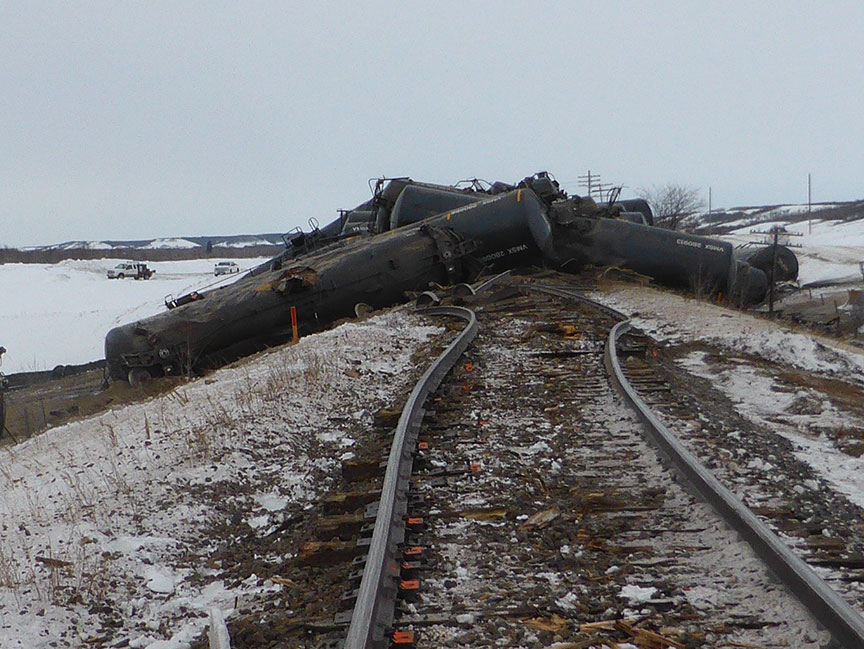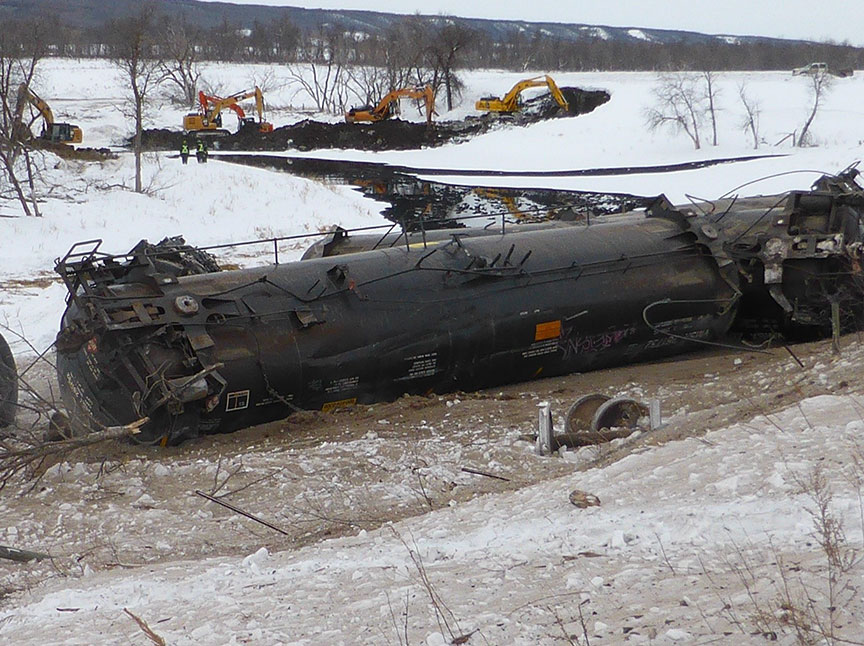Rail transportation safety investigation R19W0050
The TSB has completed this investigation. The report was published on 29 April 2022.
Table of contents
Main-track derailment
Canadian National Railway Company
Freight train U73451-11
Mile 197.47, Rivers Subdivision
St. Lazare, Manitoba
The occurrence
On ,at about 0217 Central Standard Time, Canadian National Railway Company unit train U73451-11, consisting of 108 tank cars loaded with petroleum crude oil (UN1267, Class 3 Packing Group I) and 2 covered hopper cars loaded with sand, was proceeding eastward on the Rivers Subdivision at about 49 mph when it experienced a train-initiated emergency brake application near St. Lazare, Manitoba. A subsequent inspection determined that 37 TC/DOT Class 117R tank cars had derailed near Mile 197.47. A total of 17 of the derailed tank cars were breached, which resulted in the release of about 815 000 litres of product. About 1000 feet of track was damaged or destroyed. There was no fire, there were no injuries, and no evacuation was required.
Following the derailment, crude oil pooled near a culvert on the north side of the rail line. South of the rail line, derailed tank cars had come to rest on their sides down the embankment and a large pool of crude oil had formed south of the cars. The measures put in place to protect responders, the public and the environment, as part of emergency response and site remediation activities, were generally effective.
The investigation identified a number of safety deficiencies described below.
The accident
Canadian National Railway Company (CN) unit train U73451-11 (the train) was designated as a key trainFootnote 1 operating on a key route.Footnote 2
Video from the lead locomotive forward-facing video recorder showed that, just after the locomotive passed a battery box at Mile 197.48 of CN’s Rivers Subdivision, there was a noticeable vibration of the recorded image and a loud noise was heard. Nine seconds later, the train went into emergency as 37 Class 117R tank cars, located in the 5th to the 41st positions behind the lead locomotives, derailed.
The vibration observed on the video appeared to occur as the locomotive passed over the location of 5 consecutive joints in the south rail over a distance of about 49 feet near Mile 197.47. This was also an area where the most recent track geometry inspection had revealed that the south rail exhibited consecutive surface conditions with the largest variation being about 1 inch.
In the vicinity of Mile 197.47, among the recovered track components were the 5 joints in the south rail. The fracture surfaces of 1 set of broken joint bars (joint 1) exhibited features consistent with fatigue cracking and brittle failure.
Video evidence, the presence of impact marks observed on the south-side wheel treads of the 1st to 5th cars behind the lead locomotives, and the condition of the broken joint bars in joint 1 indicate that the accident occurred when joint 1 in the south rail failed beneath the crude oil unit train.
Joint bar repair and subsequent failure
Standard joint bars and compromise joint bars are not designed to be installed together. The base of a compromise joint bar contains a 1/8 inch offset that permits 2 rails of different size (e.g., 136 pounds and 132 pounds) to be joined together such that the rail heads match. Because compromise joint bars are offset, they are manufactured as left-hand and right-hand bars so that the offsets match when installed on the field side of a rail and gauge side of a rail to make a compromise joint. A joint assembled with mis-matched joint bar types (i.e., standard and compromise) requires extra manual effort to line up the holes and install the bolts. Such a joint is unstable, will loosen over time, and could fail prematurely.
On 31 December 2018, a CN track maintenance supervisor conducted an ad hoc track inspection and identified a broken gauge-side joint bar connecting 2 pieces of 136-pound rail in the vicinity of Mile 197.47. The joint was marked with yellow paint so it could be located by a track maintenance crew and a track maintenance crew in the area was tasked with making the repair.
CN track maintenance crews usually carry four 132/136 RE standard joint bars and four 132/136 RE compromise joint bars in each maintenance crew truck. Visually, a 132/136 RE standard joint bar and a 132/136 RE compromise joint bar look very similar with only a 1/8-inch offset in the base of the compromise joint bar to distinguish it from the standard joint bar. CN Engineering Track Standards require track maintenance crews to paint compromise joint bars blue before installing them in the track.
The track maintenance crew located the broken 132/136 RE standard joint bar on the gauge side of the south rail, removed it and replaced it with what was perceived to be an unpainted 132/136 RE standard joint bar. However, a 132/136 RE compromise joint bar was inadvertently selected and installed with the 132/136 RE standard joint bar that was already installed on the field side of the rail. The installation of a compromise joint bar with a standard joint bar left the joint 1 assembly in the south rail misaligned and unstable.
Over a 6-week period, the misalignment of joint 1 led to a loosening of the joint, which initiated fatigue cracking in the joint bars. The joint bars failed when instantaneous overstress fractures occurred from the extremities of the fatigue cracking and extended through the remaining joint bar cross-sections which could no longer withstand the normal service loads applied as the train traversed the area.
In addition, track geometry testing on 23 November 2018 showed that the south rail in the general area of the derailment contained surface conditions, one being as large as 1 inch, indicating deteriorating infrastructure support at this joint. The presence of 5 joints and associated plug rails located within a relatively short distance of 49 feet adversely affected the track modulusFootnote 3 in that area and led to more rapid deterioration of joint 1 when subjected to loading as trains traversed the joint.
Relationship between train speed, track maintenance, and the severity of a derailment
Similar to other major accidents involving crude oil unit trains, although the CN crude oil train was operated in accordance with Section 4 of the TC-approved Rules Respecting Key Trains and Key Routes, the train speed (49 mph) contributed to the number of cars derailed and to the overall severity of the derailment.
The National Research Council of Canada study on factors that increase the severity of derailments involving dangerous goods noted that there is a complex relationship among train speed, train length, accident cause, and other factors that influences the severity of a derailment’s outcome. While there appears to be a linear relationship between the number of cars that derail and the speed of an accident, speed is not the only factor.
Derailments caused by broken rails, rail welds or broken joint bars had a much higher occurrence rate and derailed more cars per accident for a given speed. As speed increased, these types of derailments resulted in more severe accidents compared to other accident causes. In particular, loaded unit trains (including non-key unit trains) derailed more cars and were also involved in a larger percentage of these types of accidents. All these factors were present in this accident.
While improved tank car structure design has been shown to reduce the probability of dangerous goods (DG) release and the potential severity of an accident, the risk of a tank car being punctured or breached and releasing product exists in any derailment if the speed is sufficiently high. However, improved track repair and maintenance of key routes does reduce the likelihood of all derailments, including those involving DG.
The TC-approved Rules Respecting Track Safety (TSR) establish minimum standards for track infrastructure, and some requirements in the company engineering track standards exceed the TSR requirements. However, neither the TSR nor company standards address the need for enhanced track standards for key routes despite sometimes significant increases in DG traffic volumes, as occurred on this subdivision. This suggests that the regulatory and company track maintenance requirements may not be sufficient to protect against derailments involving DG on key routes.
To reduce the frequency and mitigate the risks associated with accidents involving key trains on key routes, it is imperative that the key route track infrastructure be adequately maintained. While the survivability of tank cars transporting DG becomes important after an accident, the most effective strategy is to address the underlying causes of accidents to prevent them from occurring in the first place.
Overall performance of the Class 117R tank cars in this derailment
All the tank cars involved in this occurrence were Class 117R tank cars. These were Class 111 tank cars built to the AAR CPC-1232 standard. The cars were equipped with jackets, insulation, and full head shields, and retrofitted with modified bottom outlet valve (BOV) handle arrangements to meet the Class 117R standard. Several of these features appear to have influenced the amount of crude oil that was released as a result of the derailment.
In previous derailments, BOV handles often had moved to the open position during the derailment, which accidently released product. In this accident, there was no crude oil spilled from the BOV despite damage to the valves.
All head breaches were associated with significant deformation of the head, which suggests that they were subjected to elevated collision forces. Despite elevated collision forces, the presence of full head shields on all the derailed tank cars likely minimized the number of tank heads that breached.
Some of the energy generated during the derailment was absorbed by the collapse of tank car jackets and insulation, which also protected against shell punctures and reduced the risk of hydrostatic tank burst or rupture.
Due to the weight of the product, about 11% of the volume of these tank cars was void space (outage). When outage is higher, there is more space available for the product to take up space within the tank, in the event that the tank becomes deformed during a derailment. The 11% average outage in the loaded tank cars further reduced the risk of a hydraulic burst of the tank shells during the derailment, which minimized the amount of product released and the potential for a fire.
The ambient temperature at the time of the accident was much colder than the flash point of the crude oil, also reducing the potential for ignition. The absence of fire at this derailment site minimized additional product release, as the crude oil that remained in the tank cars did not burn and no tank cars experienced structural failure due to exposure to a pool fire or as a result of direct flame impingement.
The overall performance of the TC/DOT Class 117R tank cars was considered to be somewhat improved as compared to the legacy Class 111 tank cars and Class 111 tank cars built to the unjacketed CPC-1232 standard that have been examined in previous TSB derailment investigations involving crude oil unit trains.
Safety action taken
Transportation Safety Board of Canada
Following this accident and 2 additional serious Canadian Pacific Railway Limited crude oil unit train derailments near Guernsey, Saskatchewan, the TSB issued Rail Safety Advisories (RSA) 02/20 and 03/20 to Transport Canada (TC) on 04 March 2020.
RSA 02/20 suggested that TC should further review and modify key train speeds, as appropriate, based on various train risk profiles while also considering other factors that influence the severity of a derailment.
RSA 03/20 suggested that TC consider revising the Rules Respecting Track Safety to include enhanced track standards for key routes.
Transport Canada
Since this accident, and in response to RSA 02/20 and RSA 03/20, TC issued Ministerial Orders MO 20-05, MO 20-06, MO 20-07, and MO 20-10 instructing the industry to develop revised Rules Respecting Key Trains and Key Routes and Rules Respecting Track Safety. The revised rules were subsequently approved by TC and contain a number of safety improvements related to the operation of key trains and track infrastructure.
Canadian National Railway Company
Since this accident, CN requires the outside surface of all compromise joint bars that are exposed when installed in track, to be spray-painted royal blue by the supplier. This allows for compromise joint bars to be more easily differentiated from standard joint bars.
Between 01 March 2019 and 31 December 2019, on the Rivers Subdivision, CN eliminated a total of 1019 temporary plug rails (2038 rail joints) and installed 192 867 feet of continuous welded rail.
Safety communications
Rail Safety Advisory 617-02/20: Modifying key train speed based on various train risk profiles
Rail Safety Advisory 617-03/20: Enhanced track standards for key routes
Media Materials
News release
The failure of a misaligned rail joint led to the derailment of a crude oil train near St-Lazare, Manitoba in February 2019
Read the news release
Deployment notice
TSB deploys a team of investigators to the site of a train derailment near St-Lazare, Manitoba
The Transportation Safety Board of Canada (TSB) is deploying a team of investigators to the site of a Canadian National train derailment near St-Lazare, Manitoba. The TSB will gather information and assess the occurrence.
Investigation information
Map showing the location of the occurrence
Investigator-in-charge

Rob Johnston has been with the Transportation Safety Board of Canada (TSB) since 2001. He was hired as a Senior Regional Investigator (Rail/Pipeline) in Winnipeg where he worked until 2004, when he assumed the position of Senior Investigator, Standards and Training Officer at TSB Head Office in Gatineau, Quebec. He became Manager of Central Regional Operations in November 2009, and has also served as Acting Director of Investigations – Rail/Pipeline for various periods since 2010. He now manages a staff of six rail/pipeline investigators in Winnipeg, Toronto, and Ottawa, and is responsible for all activities related to rail investigations in TSB’s Central Region, which extends from Cornwall, Ontario, to near the Alberta–Saskatchewan border.
During his time at the TSB, Mr. Johnston has been involved in over 70 TSB accident investigations either as an Investigator-in-charge (IIC) or as an investigation team member providing technical expertise.
Before joining the TSB, Mr. Johnston worked for Canadian Pacific Railway (CP) in Winnipeg from 1984 until 2001, where he was a member of the Train Accident Prevention group and worked in a failure analysis laboratory. He was a member of CP’s hazardous materials emergency response team for 14 years and has acquired an extensive background in mechanical operations, failure analysis, and dangerous goods.
Photos
Download high-resolution photos from the TSB Flickr page.
Class of investigation
This is a class 2 investigation. These investigations are complex and involve several safety issues requiring in-depth analysis. Class 2 investigations, which frequently result in recommendations, are generally completed within 600 days. For more information, see the Policy on Occurrence Classification.
TSB investigation process
There are 3 phases to a TSB investigation
- Field phase: a team of investigators examines the occurrence site and wreckage, interviews witnesses and collects pertinent information.
- Examination and analysis phase: the TSB reviews pertinent records, tests components of the wreckage in the lab, determines the sequence of events and identifies safety deficiencies. When safety deficiencies are suspected or confirmed, the TSB advises the appropriate authority without waiting until publication of the final report.
- Report phase: a confidential draft report is approved by the Board and sent to persons and corporations who are directly concerned by the report. They then have the opportunity to dispute or correct information they believe to be incorrect. The Board considers all representations before approving the final report, which is subsequently released to the public.
For more information, see our Investigation process page.
The TSB is an independent agency that investigates air, marine, pipeline, and rail transportation occurrences. Its sole aim is the advancement of transportation safety. It is not the function of the Board to assign fault or determine civil or criminal liability.

